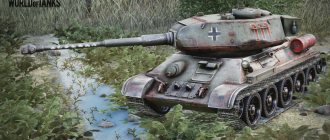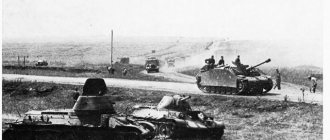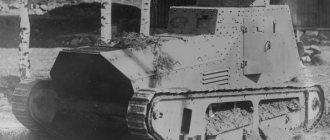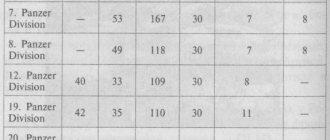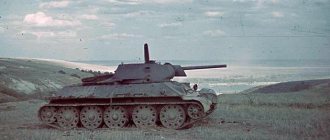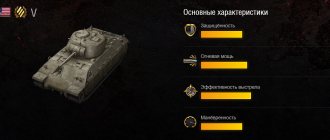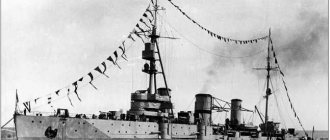How the T-90 has proven itself over the course of a year in Syria
Military operations in Syria were the first where the Russian T-90 underwent a baptism of fire.
About a year ago, these “A” modification tanks were spotted at the Khmeimim airbase used by the Russian Aerospace Forces and were intended for its defense.
The appearance in the SAR of the newest tanks available to Russia caused a strong reaction in many Western media. The speeches of experts who called the T-90A a “super tank” boiled down to the opinion that Russia had transferred several vehicles to the air base, since the Syrian government forces, armed with the T-72, were unable to provide security for the air base. The T-90 is better suited for defending such a target in the desert, as it has a more protected turret, a thermal imager integrated with the main sight, an improved gun stabilizer and an improved automatic loader. And the fire control system installed on the tank, superior to world analogues, allows the vehicle to hit moving targets with the first shot on the move in almost any weather.
Analysts from The National Interest magazine then noted that if militants of the terrorist group Daesh (the Arabic name for the Islamic State banned in the Russian Federation - RG note) use American M1A1 Abrams tanks captured in Iraq, then they will have there won't be a chance. In addition to the low professional training of the terrorists, experts also attributed the outcome of the fight to the worse equipment of the Abrams - they were exported in a version with reduced characteristics.
A few months later, it became known that some tank units of the Syrian government forces received T-90 model 1992 as military assistance from the Russian Federation. The crews were formed from SAR military personnel who had experience driving the T-72 and had undergone retraining.
For the first time, T-90s were used by Syrian troops in the province of Aleppo. Several videos have been published on the Internet depicting the participation of Russian-made tanks in battles in this region.
Middle Eastern media reported that it was the T-90s that played a significant role in the successful operations of the SAR army units. Armored vehicles ensured the advance of assault groups, as a result of which strategically important settlements were liberated and supply routes for militants were cut off. Some of the tanks were deployed in cities taken under control by Syrian troops.
In a number of sources you can also see responses from military SARs who are members of the T-90 crew. According to them, all the nuances of the Russian vehicle remain unknown to them, but past battles have already proven the effectiveness and good protection of these tanks from many types of weapons, including modern TOW anti-tank missile systems, which terrorists have in large quantities.
A clear proof of this was a video that appeared on the Internet in February of this year, filmed near Aleppo, demonstrating an attack by militants who used TOW-2A against a Russian tank. The rocket hit the front of the tower. The scene of the jubilant soldiers came to an abrupt end after a live crew member emerged from the tank's turret. Later, a photo appeared of the T-90 that was hit, which was at a Syrian repair plant. It was reported that the vehicle's sight heads and dynamic protection units were replaced.
Also indicative are the footage, which shows how the T-90 withstands being hit by three missiles. According to the participants in the battle, the terrorists first fired one rocket at the car, then two more. The first exploded on approach, the second slightly damaged the track, and the third completely missed. The tank managed to continue moving and shooting.
In the ranks of the SAR military personnel, according to some sources, the opinion is often heard that a larger number of T-90s would contribute to a quick end to hostilities in the country.
According to expert on the Syrian crisis Yuri Lyamin, quoted by Vestnik Mordovia, the SAR government forces have no more than three dozen T-90s at their disposal.
“These tanks are spread out along the front line. No more than one company is used in one direction. For example, near Aleppo at the end of last year and the beginning of this year, there were only about a dozen cars,” Lyamin noted.
The publication also notes that since its appearance in Syria, not a single T-90 has been destroyed. The only loss can be considered the seizure of an almost serviceable tank by militants in the Aleppo region in early June.
Tanks: ISIS burned 48 Abrams and not a single T-90
The Rossiya-1 TV channel featured the T-90S tank, which was equipped with additional protection that significantly increased its survivability. First of all, the most vulnerable side projections of the tank are protected. They are equipped with new lattice screens that reduce the impact of tandem ammunition. As well as additional dynamic protection plates covering the most vulnerable spots of the tank. In September, this type of protection was successfully tested on T-72M3 tanks during the Zapad 2017 exercises.
This is the so-called “urban defense”, intended for battles when the enemy can fire at the tank from all sides. In this case, the blows are delivered to the least protected sides. Moreover, shelling not only by anti-tank missiles that have a tandem cumulative warhead, but also by grenades from the seventies may prove critical. The situation is further aggravated by the fact that strikes can be delivered at close range. The operation of Russian tanks in Syria showed the urgency of introducing additional protection.
True, in order to make such a “discovery”, it was not at all necessary to transport tanks to Syria. It was enough to look at the statistics on the losses of American Abrams tanks in Iraq at the beginning of the last decade. Based on the bitter experience they had gained, the Americans began hastily attaching “urban defense” to their tanks.
Actually, the Russian military, very familiar with the direction of modification of the Abrams, decided in advance to do approximately the same thing. In 2012, the Main Armored Directorate of the Ministry of Defense began developing tactical and technical requirements for the “urban kit”. Then a tender was announced for its creation, which was won by the Steel Research Institute. And now tanks are starting to receive additional protection.
Urban Defense is not unique. In addition to American Abrams, it is used on French Leclercs, German Leopards, and Israeli Merkavas.
It must be said that the Soviet Union was the first country that began to create tank protection for urban battles. These works began in the 70s. For the Afghan war, a kit for the T-64 tank was created. However, after the collapse of the USSR, this kind of work was curtailed.
“Breakthrough” against “Armata”: the T-90M tank went to the troops
According to the press service of Uralvagonzavod, the concern has begun serial production and delivery of T-90M Proryv tanks to the troops. Moreover, we are talking about “long-term contracts for a large number of machines.”
And although the number of tanks of this type ordered by the Ministry of Defense is not specified, we can still say that this news is very important and, it seems, positive.
Although, let's be honest, it also has a certain bitter taste. Most likely, the start of large purchases of the T-90M Proryv tank means that the prospects for another tank, the T-14 Armata, which experts consider the best in the world in many respects, are not at all brilliant, and our armed forces will not see them in the foreseeable future it in quantities exceeding a hundred or two pieces. But more on that later, but for now a little about what the new version of the not-so-new T-90 tank is.
The T-90M is the most advanced modification of the T-90 tank, developed back in 1992. In turn, many experts believe that the T-90 tank is just a deep modernization of the T-72 tank, which appeared in our army back in 1973. And with all due respect to this well-deserved and very successful machine, many experts believe that its modernization potential is already, to put it mildly, close to zero.
However, if you look closely at the new T-90M tank, you will notice that the basic platform has undergone very large changes, and this is a truly deep modernization, close in scale and complexity to the new vehicle.
First of all, the deeply modernized tower attracts attention. The developed aft niche of the new turret makes it possible to organize the stowage of ammunition in it. This arrangement helps to avoid complete destruction of the tank if the ammunition is damaged and helps the crew to survive. There is also information that the new automatic loader is capable of working with high elongation sub-caliber projectiles, which has a positive effect on the anti-tank capabilities of the T-90M tank. Another distinctive feature of the turret is the new multi-layer armor, which, coupled with dynamic protection, allows it to cope with almost any modern anti-tank ammunition flying at the frontal projection of the tank. And the hull armor in the front projection has been strengthened so much that its penetration has become almost impossible for existing tank gun ammunition.
There is probably no particular need to say that this tank can be equipped with the most modern active and dynamic protection systems. Thus, the Relikt dynamic protection, the installation of which is provided for by the project, is several times superior in its characteristics to the Kontakt-5 ERA. It can also be equipped with the Arena-M active protection complex, which is capable of detecting enemy ammunition at a great distance, calculating its trajectory and destroying it with a counter shot from a special combat element.
However, it is probably not entirely correct to talk about new items in the tank body kit, since they can be installed on almost any modern Russian tank. New systems for protection, surveillance, targeting, data exchange, camouflage - all this is good in itself, and the T-90M tank, of course, will only benefit if it is equipped with all these new products. The latter, however, no one guarantees - all these wonderful systems cost quite a lot of money, and such a “tuned” T-90M will be very expensive. And, as you know, we don’t have money...
What can rightfully be attributed to the qualitative progress of the tank itself is the V-92S2F tank diesel engine with a power of 1130 hp. This power plant allows it to reach speeds of up to 45 km/h over rough terrain, and up to 70 km/h on the highway. Specific power with a dead weight of 48 tons reaches 22.5 hp. per ton, which is very good. The power reserve, with external tanks, is a respectable 550 kilometers.
The tank also received an auxiliary power unit, namely a diesel generator, necessary to generate electricity when the engine is turned off. And this is not a whim at all - the functioning of on-board systems, data exchange, communication, and the activation of emergency systems, such as KAZ, depend on whether there is electricity in the on-board network. A compact generator that can be turned on in parking lots is significantly more economical, and, most importantly, it reveals less about the tank in the infrared range, and this is already critically important in our age of secretive drones and long-range precision-guided ammunition.
The main weapon of the tank was the not very new 2A46M-4 cannon. Initially, it was assumed that the T-90M would be equipped with a 2A82 cannon, but the military agreed (and some say that they themselves insisted) on installing a time-tested and reliable cannon of the previous generation. Its combat characteristics are not much worse, so the choice in favor of reliability can be considered acceptable. Although it is quite possible that the main selection criterion was again the price - the military, taking into account all the budgetary difficulties, clearly do not want to “inflate” the price of the new model. Ultimately, this may simply make the entire project pointless if it comes close in price to the Armata, which was already ready for mass production and superior to all possible modifications of the T-90 even before they were conceived. One way or another, for now we can consider the 2A46M-4 gun to be quite reasonable, and most importantly, a temporary compromise, thanks to which the tank can be brought to mass production at minimal cost. And the gun can be replaced later, when (and if) the Ministry of Defense has more money...
It is also worth noting the possibility of integrating the T-90M into the network-centric battle control system ESU TZ (Unified Tactical Level Control System). In simple terms, the tank can be connected to the “military Internet”, where it can automatically exchange information with other tanks, the headquarters of its unit, allied reconnaissance drones, and so on. Thanks to this, the crew’s awareness of what is happening on the battlefield will not only increase, but also the reaction time to threats that the crew does not yet notice, but which other allied “units” are already aware of, will sharply decrease. And this is nothing more than the survivability of the tank and crew.
There is probably no particular need to say that the T-90M tank is equipped with a two-channel day/night gunner’s sight, in this case the Sosna-U model. In addition, there is a panoramic sight for the PAN commander. All this is integrated into the Kalina fire control system, which has already been used on some modifications of the T-90 tank, in particular on the T-90A tank. The tank has a two-plane gun stabilizer and a target tracking system, which significantly increases accuracy when firing from a place and immediately.
This model was first demonstrated back in 2022, and it was assumed that its mass production would begin in 2019-2020. But inevitable fine-tuning and organizational discrepancies slightly delayed the start of mass production. However, there is no war now, and such a shift can probably be considered acceptable.
As can be seen from the description, we actually received a vehicle that is significantly different from previous models and, in terms of its combat capabilities, is probably one of the best today. And this, of course, is good news...
On the other hand, it is already obvious that the launch of serial production of the T-90M at the facilities of Uralvagonzavod will postpone for an unknown period the serial production of the T-14 Armata tank, which many are already calling the tank of tomorrow. Alas, with all the advantages of the T-90M, it is inferior to the Armata in terms of security, dynamics, combat power, and a number of less significant, but still important parameters.
The recent declassification of the Armata and the appearance of its mock-up at the IDEX-2021 international exhibition in the UAE added fuel to the fire. The tank, which they vowed not to sell to anyone until the needs of the Russian Armed Forces were met, has now become an ordinary export product. This means that the financial issue still prevailed, and the Russian Ministry of Defense decided to purchase, albeit quite good, but still a less advanced T-90M tank.
Now there are already cautious conversations about which of these tanks will ultimately be the main one for the Russian ground forces. Experts, known for their “principles,” agree that the main tank will be the one that will be “purchased in greater numbers.” This purely arithmetic approach also probably has a right to exist. And yet, let's be realistic - it hardly makes much sense to further expand the line of MBTs, of which we already have three - T-72, T-80 and T-90. This means that, most likely, we should not see the “Armata” appear in our armed forces at all, if we keep in mind the quantities that will allow us not to consider them experimental samples and a statistical error.
But maybe that's not the main thing. We just have enough for parades, right? And we will make “Armat” for parades, there is no doubt about that...
Operation and modifications
The T-90MS tank was first presented to the public in 2011. In 2016, India, one of the main operators of the T-90, ordered a batch of tanks. Kuwait and Egypt have shown interest in the tank, and the Egyptians expect to deploy the assembly at home. In Kuwait, the T-90MS should replace the aging M-84 - T-72, still assembled in Yugoslavia. In Russia itself at that time it was believed that the T-14 Armata would become the main vehicle of the armored forces.
However, when production of the Armata stalled, interest in the T-90 returned. The version for the Russian army was designated T-90AM ("modernized T-90A"). It differs from the T-90MS in the use of the new Afghanit active protection system. In addition, the unit management complex is integrated into a unified tactical level management system.
But this modification of the T-90MS is not “final”.
There are plans to upgrade all Russian T-90s to the T-90M standard. It is assumed that it will have a standard KORD machine gun installed in its remote mount, and the gun will be replaced by a 2A82, developed for the T-14 Armata (for which new shells have been developed). And the fuel tanks are isolated from the fighting compartment by bulkheads made of thin armor.
Technical characteristics of T-90MS
Dimensions:
— Weight 48 tons.
— Length 9530 mm.
— Width 3780 mm.
— Height 2228 mm.
Weapons:
— The 125-mm 2A46M-5 or 125-mm 2A82 gun-launcher is the main combat weapon of the tank, designed to destroy all types of ground, surface (within range) and low-speed air targets. Ammunition of 40 artillery shells of various types: BOPS, OFS, KS or guided missiles (UR) 9K119M "Reflex-M".
The upgraded 2A46M-5 gun has the following design differences from the serial 2A46M guns:
- the barrel has a differentiated tolerance for wall thickness in the muzzle;
- thickness difference is no more than 0.6 mm,
- trunk rigidity increased to 420 kgf/cm,
- 2A46M-5 gun barrels are interchangeable with 2A46M gun barrels;
- the barrel guides in the cradle are of a prismatic type, the cantilever of the barrel in the cradle has been reduced and the neck of the cradle has been lengthened by 160 mm;
- the rear guide from the cradle box was moved to a more rigid frame part, made by surfacing bronze, this design eliminated the quick-release connection of the pipe with the breech;
- additional backlash selecting devices were introduced in the neck of the cradle (2 pcs.), in the backlash selecting devices, rollers were used instead of stops, which eliminated the influence of wear on the stops on pressing the barrel to the cradle guides and reduced the friction force in this connection by replacing sliding friction with rolling friction;
- backlash-free trunnion units with elastic rollers and a reverse wedge are used, due to which the influence of play in the trunnions on shooting accuracy is reduced;
- To automatically take into account the bending of the barrel when firing, a reflector of the barrel bending accounting device (BUD) is mounted on the muzzle of the pipe.
— Coaxial 7.62-mm machine gun 6P7K (PKTM) with a cannon. It is designed to combat enemy personnel that are within the firing angles of the main weapons. The machine gun is paired with the cannon and has the same field of fire as it. Ammunition capacity: 2000 rounds of 7.62mmx54R cartridges of various types. This weapon is installed in a completely new circular rotation turret with a developed turret niche.
— Remote-controlled machine gun mount T05BV-1 with a 7.62-mm machine gun 6P7K (PKTM). Designed to combat enemy manpower, which is hidden either higher than the firing range of the main weapon, for example, on the upper floors of buildings, steep mountain slopes. Either below the firing sector of the main weapon, in shelters, dugouts, or directly next to the tank in the so-called. “dead zone” for a tank gun and a coaxial machine gun. Thus, according to the designers, the combat stability of the tank in cramped and urban combat conditions should be ensured. Ammunition capacity: 800 rounds of 7.62mmx54R cartridges of various types.
Fire control, surveillance and target detection system:
— Fully digital, highly automated control system “Kalina” with a BIUS integrated into it. Thermal imaging and television devices intended, among other things, for all-round surveillance.
Security:
— Multilayer combined armor of the latest design in the frontal part.
— Spaced armor on the side.
— The latest built-in dynamic protection “Relic”.
— Local protection of ammunition.
— Measures that reduce the thermal and noise signature of the tank.
Mobility:
— Multi-fuel diesel engine V12 V-92S2F2 with a power of 1130 hp. (831kW) + automatic transmission.
— Power supply ~23 hp/t.
— Maximum speed 60-65 km/h on the highway.
— Power reserve 500 km.
The tank was created on the basis of previous modifications: T-90A and T-90S. Now let's look in more detail at what differences we see on this machine. What immediately catches your eye can be listed point by point:
- New tower with a developed aft niche.
- New 125 mm 2A82 gun.
- New dynamic protection "Relic".
- The tank does not have the KAZT Arena-E active protection system.
- The KOEP “Shtora” optical-electronic suppression kit is not available on the tank.
- Finally, the tank received a normal hard armored hull bulwark, generously flavored with Relikt dynamic protection elements and lattice screens in the rear.
- The anti-aircraft gun with the NSVT large-caliber 12.7-mm machine gun has sunk into oblivion. Its place was taken by a new machine gun mount with a 7.62 mm 6P7K machine gun.
- Slightly more powerful V-92S2F2 engine + automatic transmission.
- The tank received an additional power unit in an armored container mounted at the rear of the hull on the left.
What else can you say about this car?
- The body, like the previous modifications, mainly remained from the T-72.
- There are also no significant differences from the T-72 in the chassis.
- The new Kalina fire control system is clearly superior to the 1A45T Irtysh of the T-90A tank.
